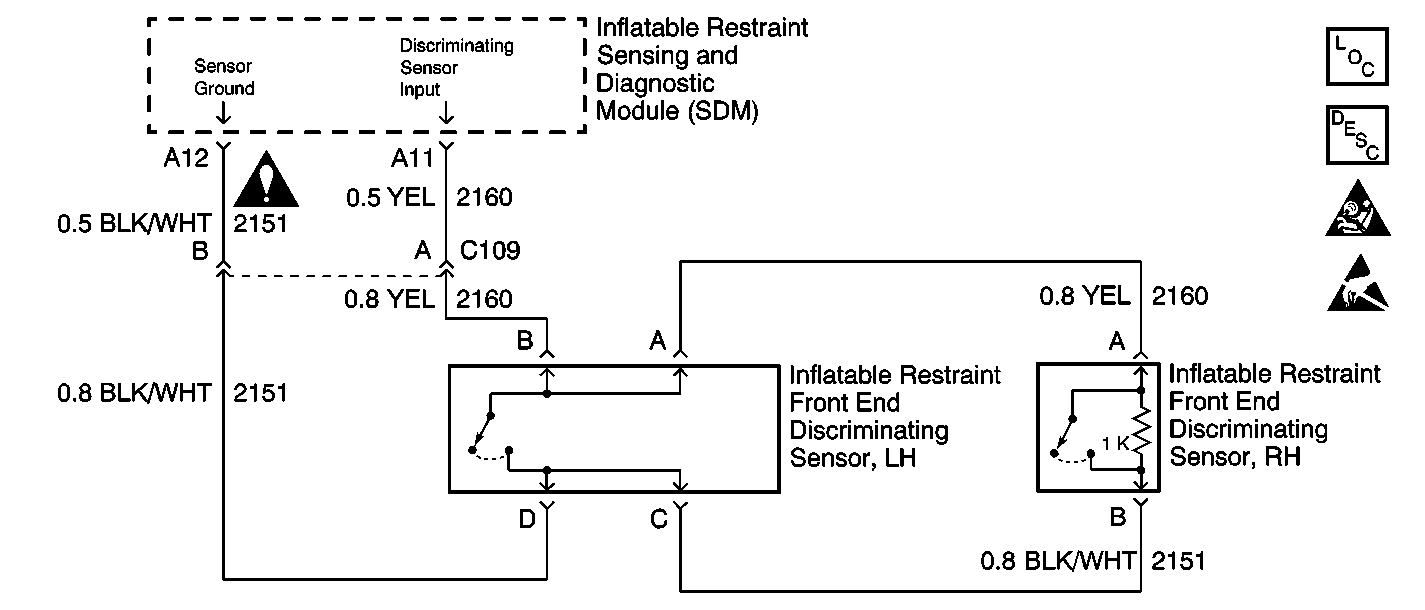
Circuit Description
When you first turn the ignition switch to the RUN position, the inflatable restraint sensing and diagnostic module (SDM) performs tests to diagnose critical malfunctions within itself. The SDM then measures the following circuits to ensure they are within their respective normal voltage ranges:
| • | Ignition positive voltage. |
| • | 23 voltage loop reserve (VLR). |
| • | Deployment loop voltages. |
The SDM then proceeds to CONTINUOUS MONITORING. The SDM contains a resistor network connected to 5 volts, ground, and to the SDM discriminating sensor signal input. The SDM monitors two front end discriminating sensors that are wired in parallel. The 1.0 K ohm resistor located in the RH inflatable restraint front end discriminating sensor is parallel to the normally open switch which provides a parallel path to ground. This causes a specified percentage of voltage to appear at the SDM discriminating sensor signal input. The SDM monitors this voltage to detect shorts to ground or a closed discriminating sensor.
Conditions for Setting the DTC
| • | The SDM is configured for two inflatable restraint front end discriminating sensors. |
| • | The voltage at the discriminating sensor signal input is 0.5 volts or less for 5 consecutive samples. |
Action Taken When the DTC Sets
| • | The SDM sets DTC B0035. |
| • | The SDM disables the discriminating sensor input. |
| • | The SDM commands ON the AIR BAG warning lamp via Class 2 serial data. |
Conditions for Clearing the DTC
| • | Current DTC |
| - | Discriminating sensor signal input is greater than .5 volts for 5 consecutive samples. |
| - | CLEAR CODES command. |
| • | History DTC |
| - | You issue a scan tool CLEAR CODES command. |
| - | After 255 malfunction free ignition cycles have occurred |
| • | When the SDM detects that no DTCs are present, the SDM commands the AIR BAG warning lamp OFF. |
Diagnostic Aids
A short to ground in the inflatable restraint front end discriminating sensor circuits may cause an intermittent condition. Inspect the discriminating sensor input circuits carefully for any cutting or chafing.
When measurements are requested in this table, refer to Circuit Testing. When an inspection for proper connection is requested, refer to Testing for Intermittent and Poor Connections. When a wire, connector, or terminal repair is requested, refer to Wiring Repairs and Connector Repairs.
Test Description
The numbers below refer to the step numbers on the diagnostic table:
-
Tests for a malfunctioning discriminating sensor.
-
Tests for a short to ground in the discriminating sensor input circuit.
-
Tests isolates a short to ground in the discriminating sensor input circuit to one side of the in-line connector.
Step | Action | Value(s) | Yes | No |
|---|---|---|---|---|
1 | Did you perform the SIR Diagnostic System Check? | -- | Go to Step 2 | |
Does the resistance measure more than the specified value? | 950 ohms | Go to Step 3 | Go to Step 7 | |
Does the resistance measure less than the specified value? | OL | Go to Step 4 | ||
Does the resistance measure less than the specified value? | OL | Go to Step 5 | Go to Step 6 | |
5 | Locate and repair a short to ground in the discriminating sensor input circuit between the discriminating sensor in-line harness connector and the discriminating sensor harness connector. Refer to Wiring Repairs in Wiring Systems. Did you complete the repair? | -- | Go to Step 8 | -- |
6 | Locate and repair a short to ground in the discriminating sensor input circuit between the discriminating sensor in-line harness connector and the inflatable restraint sensing and diagnostic module (SDM) harness connector. Refer to Wiring Repairs in Wiring Systems. Did you complete the repair? | -- | Go to Step 8 | -- |
7 | Replace the inflatable restraint front end discriminating (RH) sensor. Refer to Inflatable Restraint Front End Discriminating Sensor Replacement . Did you complete the replacement? | -- | Go to Step 8 | -- |
8 |
Does the DTC reset? | -- | Go to Diagnostic Aids |
